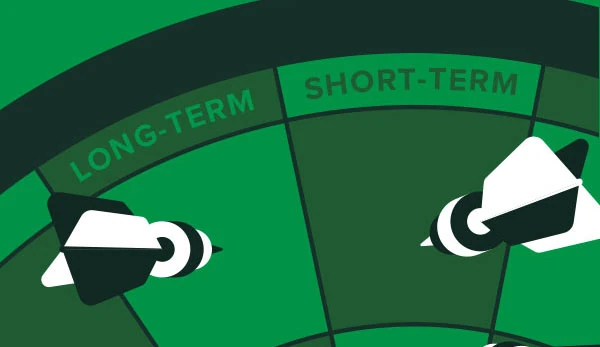NOTICE: Internet Explorer was retired by Microsoft on June 15th, 2022 and is no longer supported. This could change how you access Online Banking.
Diversify Investment Options & Manage Investment Risk

Get to Know Your Investment Options and the Value of Diversifying Investments
How to Manage Investment Risk With a Diverse Portfolio
The key elements to a healthy financial mindset are knowing how to spend, save, invest, borrow and plan. Understanding the ins and outs of these core components will help you become and stay financially healthy. A savings account is the first step and a great way to start planning for your future, but if you’re looking for a higher return over time, it’s time to consider investing.
Before putting together an investment portfolio, you’ll want to follow some general guidelines that will help your money work for you. The most important is to diversify investments, which allows your investment portfolio to have a broad range of investments. Since there’s no one perfect investment, your goal is to invest in a combination of individual investment options across the asset classes that work with your goals and risk tolerance.
Different Investment Options to Include in Your Portfolio
There are various investment options to choose from when diversifying your portfolio. It’s beneficial to have a balance of short-term investments and long-term investments so that you’re able to maintain access to your earnings even as your funds grow for the future.
Short-Term Investment Options
Short-term investment options allow you to grow your money and access those funds quickly. Consider investing funds for the short term if you’re looking to purchase a car, planning a wedding or saving for a down payment on a home. These short-term investment options are ideal for those who want guaranteed returns and lower investment risk:
- Money Market Accounts: High-yield savings accounts that allow you to earn more, with higher interest paid on higher balances.
- Mutual Funds: Consist of a portfolio of securities in which the shares are sold to investors who then earn interest over time.
- Exchange-Traded Funds (ETFs): Collection of securities that trade throughout the day with typically low- or zero-commission fees and low expense ratios.
Long-Term Investment Options
Looking to invest for the long haul? There are several long-term investment options you’ll want to look into that have lower investment risk, including CDs, bonds and retirement savings accounts. While stocks and other securities carry higher risk, they may offer greater reward over time. Long-term investment options should be used to build your wealth, fund your retirement or act as a form of income:
- Certificates of Deposits (CDs): A bank or credit union product that allows customers to earn higher interest rates by leaving a lump-sum deposit untouched for a specified amount of time.
- Bonds: A long-term investment option that must reach maturity, and then the bondholders receive the principal and the income earned on the bond. There are a variety of bonds to choose from, including municipal bonds, government bonds and corporate bonds.
- Public Stock: A public corporation’s shares, which are made available for the public to purchase.
- Private Stocks: Ownership is limited to a small group of employees or internal company investors.
- Standard Brokerage Account: A way to purchase shares by depositing money yourself or permitting a licensed professional to invest it for you.
- Retirement Funds: Traditional and Roth 401(k) and IRA plans invest in the stock market, which creates a reliable and safe pathway to a healthy retirement fund. Some 401(k) accounts are employer-sponsored, and it’s wise to contribute as much as you can to a 401(k) or IRA before delving into other types of investing.
Follow These Fool-Proof Portfolio Guidelines
Now that we’ve covered basic investment options, you’ll want to keep some of these guidelines in mind as you begin to diversify your investments. The ideal portfolio has some combination of the following:
- Growth: Stay ahead of inflation with investments that increase in value over time. Stocks, stock funds and real estate are typical growth investments.
- Income: You may need regular income from your investments, especially if you’re retired. Bonds, bond funds and CDs are typical income investments that will allow for easier withdrawals.
- Liquidity: You never know when you might need cash quickly. In case of an emergency, you want to have some liquid investments, such as money market funds and short-term CDs.
- Risk: There’s no such thing as a risk-free investment. Higher growth and income come with more volatility and the risk of losing your principal. On the other hand, higher liquidity comes with a risk of falling behind the rate of inflation. Owning a number of assets with different types of investment risk can help protect you from losing too much on any one format.
How to Create a Balanced Portfolio
Your investment needs change over time, and it’s important to periodically review your risk tolerance, growth goals and liquidity to ensure you’re making the most of your investments. For example, most financial advisers suggest younger investors allocate a greater percentage of their portfolio to growth than older investors, since they have more time to recover from a potential drop in value due to higher investment risks. As you near retirement, you may want to shift some of your funds to income investments or other lower-risk options.
Having a balanced portfolio leads to steadier returns and gives you liquidity in savings. WesBanco can help you review your portfolio and see where you can diversify investments and how you should adjust as your needs change.
1Wealth Management Services include WesBanco Trust and Investment Services (WTIS), a division of WesBanco Bank, Inc.; WesBanco Securities, Inc. (WSI), a wholly owned subsidiary of WesBanco, Inc. and a member of FINRA and SIPC; and WesBanco Insurance Services (WIS). WIS is licensed in the states of DC, IN, FL, KY, MD, MI, OH, PA, VA and WV. WTIS may invest in insured deposits and nondeposit investment products. WSI and WIS invest in nondeposit investment products. Nondeposit invest products are not insured by the FDIC, not bank guaranteed, not insured by an government entity and are subject to investment risk, including possible loss of principal amount invested. Investment options identified in this article may not all be available through the various WesBanco entities.
Content is for informational purposes only and is not intended to provide legal or financial advice. The views and opinions expressed do not necessarily represent the views and opinions of WesBanco.
While we hope you find this content useful, it is only intended to serve as a starting point. Your next step is to speak with a qualified, licensed professional who can provide advice tailored to your individual circumstances. Nothing in this article, nor in any associated resources, should be construed as financial or legal advice. Furthermore, while we have made good faith efforts to ensure that the information presented was correct as of the date the content was prepared, we are unable to guarantee that it remains accurate today.
Source: Banzai Financial Literacy Curriculum. Neither Banzai nor its sponsoring partners make any warranties or representations as to the accuracy, applicability, completeness or suitability for any particular purpose of the information contained herein. Banzai and its sponsoring partners expressly disclaim any liability arising from the use or misuse of these materials and, by visiting this site, you agree to release Banzai and its sponsoring partners from any such liability. Do not rely upon the information provided in this content when making decisions regarding financial or legal matters without first consulting with a qualified, licensed professional.

